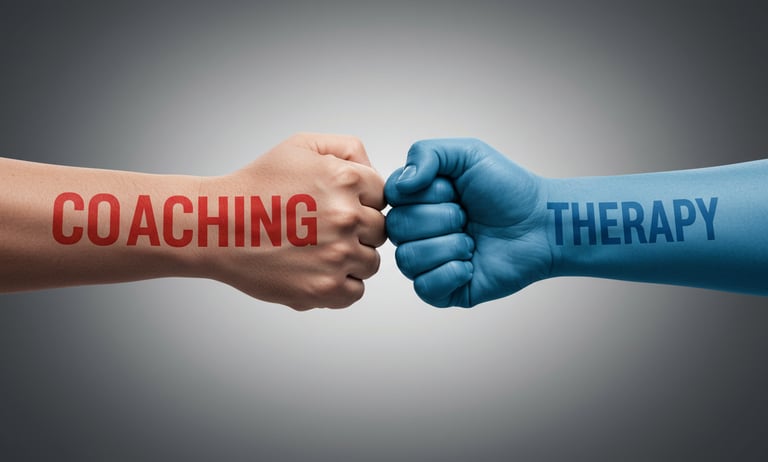Therapy vs. Coaching: What Actually Creates Real Change?
This blog helps high-achieving professionals understand the key difference between coaching and therapy. While coaching drives action, therapy uncovers the deeper patterns that block sustainable progress. If you’ve optimized everything but still feel stuck, this article shows why therapy might be the missing piece.
COACHINGPROFESSIONALSEMDR THERAPY


Coaching vs Therapy: What Actually Creates Real Change?
You’re already a high-functioning person.
You’ve read the books. Hired the coach. Joined the mastermind.
You’ve optimized your calendar, your productivity, and maybe even your diet.
But here you are.
Still overthinking.
Still hitting walls.
Still wondering why the progress doesn’t feel like peace.
This is where a lot of high performers get stuck:
Do I need a coach or a therapist?
Here’s the truth: both have value.
But they work at very different levels of the system.
And when you’re trying to make real, lasting change, you need to know which one your current struggle actually requires.
Coaching Helps You Move Forward.
Therapy Helps You Understand Why You’re Stuck.
Let’s break it down:
Coaching is:
Forward-focused
Structured around goals and accountability
Action-oriented
Designed to optimize behaviors and outcomes
Often based on performance metrics or success benchmark
It’s helpful when you already feel emotionally regulated and just want support achieving something you’re clear about.
But what if you’re not clear?
Therapy is:
Rooted in emotional insight and identity-level exploration
Focused on understanding the why behind your behaviors
Built for complexity, contradiction, and emotion
Structured to transform the internal system, not just change the output
Evidence-based, often using deep modalities like EMDR Therapy, parts work, psychodynamic and existential approaches
Therapy is where you stop tweaking systems
and start understanding the one running inside you.
Why Coaching Sometimes Stops Working
Here’s a pattern we see all the time:
You crush it for a few months
You set goals and hit them
You burn out, plateau, or sabotage progress
You blame discipline, mindset, or “not showing up”
You re-hire a coach or start the cycle again
But what’s actually happening?
You’ve reached the limit of what behavior change can do
There’s unprocessed material that coaching can’t touch
You’re optimizing on top of a system that’s still in survival mode
That’s not a coaching failure.
That’s a sign therapy is the next layer of work.
The more intelligent and driven you are, the easier it is to hide the deeper stuck points under achievement. You’re disciplined enough to compensate, but not free enough to feel fulfilled. Coaching amplifies your discipline. Therapy expands your emotional capacity so that discipline doesn’t have to carry everything alone.
What Therapy for High Performers Looks Like
This isn’t weekly venting or advice from someone who doesn’t understand business.
This is structured, strategic, depth work from therapists who understands executives and professionals.
We focus on:
The internal parts of you that sabotage, overachieve, avoid, or collapse
EMDR therapy to process the deeper emotional imprints of stress, perfectionism, rejection, or identity confusion
Nervous system work to help you regulate instead of white-knuckling your progress
Exploration of meaning, fulfillment, and self-worth beyond achievement
You don’t lose your edge.
Clients often say things like:
“I didn’t realize how much I was pushing from fear until I stopped.”
“I thought I needed more accountability. Turns out, I needed emotional clarity.”
“I finally understand why I kept sabotaging the things I worked so hard for.”
That’s the difference therapy makes. It connects the dots between your actions and your emotional architecture.
Case Study: When Coaching Plateaued (Edited For Privacy)
Nina, a 42-year-old founder of a successful startup, had worked with multiple executive coaches. She’d scaled her business, led a dynamic team, and appeared unshakably confident. But privately, she was anxious, detached, and feeling hollow.
She described her coaching sessions as "practical but repetitive."
"I knew exactly what I needed to do," she said, "but I couldn’t make myself care. It felt like my goals were scripted—not mine."
In therapy, we uncovered that her overperformance was rooted in early dynamics where being competent was the only way to receive attention. She wasn’t burned out from effort, she was burned out from disconnection.
Using EMDR and parts work, we targeted formative experiences that taught her to disconnect from emotional needs and rely solely on logic and control.
After a few months, Nina reported:
Clearer boundaries with clients and team members
More creative energy ("I'm sketching again I forgot I even liked that")
A sense of internal alignment: "Now I actually want what I’m building."
She didn’t ditch coaching. She returned to it later with clarity, intention, and fewer internal blocks. And it worked better than ever.
The Best Use of Coaching? After Therapy.
Once you’ve worked through the emotional material that runs your “default mode,” coaching becomes exponentially more effective.
You execute without emotional resistance
You understand your patterns, so you can work with them instead of against them
You grow from clarity, not pressure
You stop chasing goals that don’t feel satisfying once you reach them
Therapy gives you alignment.
Coaching gives you amplification.
Most people do it backwards.
And in doing so, they waste time, money, and emotional energy on optimization strategies that never touch the real problem.
A well-timed pivot to therapy is not a retreat. It’s a power move that recalibrates your trajectory instead of forcing more effort into a misaligned direction.
FAQs: Therapy vs. Coaching for High Performers
Can I do therapy and coaching at the same time?
Yes, but it works best when you’re using therapy to address underlying patterns and coaching to execute once clarity returns. Otherwise, they can compete for emotional bandwidth.
Is therapy slower than coaching?
Not necessarily. Therapy can create rapid internal shifts that solve the root issue behind years of cyclical behavior. Coaching can feel faster but often needs to be repeated when the internal system hasn’t changed.
What if I don’t feel messed up enough for therapy?
Therapy isn’t just for crisis. It’s for recalibration, integration, and upgrading the internal system that drives your external performance. It’s not about fixing what's broken, it’s about aligning what’s already working with what you actually want.
Want to Figure Out What You Actually Need Right Now?
Book a free 30-minute Zoom consultation.
We’ll talk about what you’re working on, what’s getting in the way, and whether therapy fits the moment you’re in.
